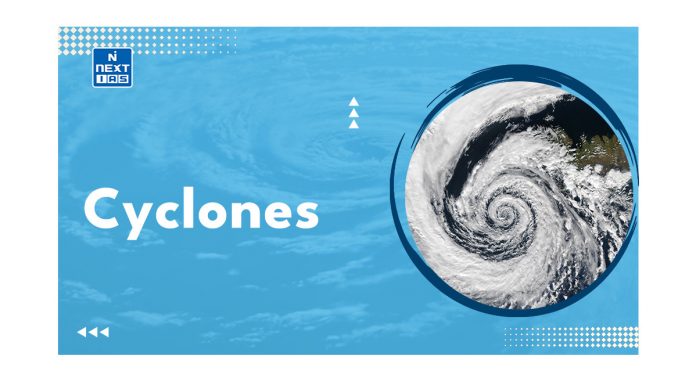As Cyclones Biparjoy approached authorities in Gujarat began evacuating thousands of people from vulnerable areas and closed schools and ports in coastal districts.
What are Cyclones?
- They are characterized by rapid inward air circulation around a low-pressure area.
- In the Northern Hemisphere, the air circulates in an anticlockwise direction, while in the Southern Hemisphere, it circulates clockwise.
- These atmospheric phenomena are often accompanied by violent storms `and adverse weather conditions.
Types of Cyclones
Tropical Cyclones
| – These are also referred to as hurricanes or typhoons, depending on the region. – The World Meteorological Organization (WMO) defines tropical cyclones as weather systems in which winds exceed “Gale Force” with a minimum speed of 63 kilometers per hour. (“Gale force” is a term used to describe very strong winds and is a way to measure the speed of the wind.) – These are typically developed in the region between the Tropics of Capricorn and Cancer. – They are large-scale weather systems that form over tropical or subtropical waters, where they organize into surface wind circulation. |
World Meteorological Organization (WMO)
| – It is a specialized agency of the United Nations responsible for promoting international cooperation in meteorology, climatology, hydrology, and related fields. – It was established in 1950 and currently has 193 member countries and territories. – The primary goal of the WMO is to facilitate the exchange of weather and climate information among member countries. – It fosters partnerships and facilitates the development and implementation of international frameworks and agreements, such as the Intergovernmental Panel on Climate Change (IPCC) reports and the Global Framework for Climate Services (GFCS). |
Formation of Tropical Cyclones
- Tropical cyclones are violent storms that form over warm tropical oceans and move toward coastal areas, causing widespread destruction through strong winds, heavy rainfall, and storm surges.
- They are considered one of the most devastating natural disasters worldwide.
- The formation and intensification of tropical cyclones depend on several favorable conditions including
- a large sea surface with temperatures exceeding 27°C.
- the presence of the Coriolis force.
- minimal variations in vertical wind speed.
- pre-existing weak low-pressure area.
Stages of Tropical Cyclones Formation
- Early Stage: water vapor and heat are transferred from the warm ocean to the air above, leading to the formation of vertical cumulus clouds through convection and condensation.
- Mature Stage: As the tropical storm intensifies, vigorous thunderstorms cause the air to rise and spread out horizontally at the tropopause level. This results in positive pressure at higher levels, which accelerates the downward motion of air due to convection.
- The warm “Eye,” a low-pressure center, is formed during this mature stage.
- Final stage: Eventually, a tropical cyclone begins to weaken as its source of warm moist air diminishes, such as when it makes landfall or passes over cold waters. This leads to a decline in central low pressure, internal warmth, and high speeds.
Extratropical Cyclones
- They are also known as temperate cyclones, middle-latitude cyclones, frontal cyclones, or wave cyclones.
- While temperate cyclones originate in the Polar Regions, they affect temperate zones and high-latitude regions.
Formation of Extratropical Cyclones
- The formation of extratropical cyclones can be explained through the Polar Front theory. This theory highlights the interaction between warm, moist air masses from the tropics and cold, dry air masses from the poles. The collision of these contrasting air masses leads to the creation of a polar front, where the denser cold air forces the warm air to rise.
- This process generates instability and results in the development of a low-pressure area at the center of this air mass interaction.
- As a consequence of the reduced pressure, air from the surrounding areas moves in to fill the void, forming a cyclonic circulation.
Cyclones in India
- Tropical cyclones originate over the Bay of Bengal, the Arabian Sea, and the Indian Ocean. These cyclones bring about high wind speeds and heavy rainfall, affecting coastal states in India such as Tamil Nadu, Andhra Pradesh, West Bengal, Odisha, and Gujarat.
- In the last few years, India has faced many cyclones including Amphan, Sitrang, Fani, Asani, Yaas, Nisarga, and Tauktae.
Measures to Manage
- Structural measures include the construction of cyclone shelters, cyclone-resistant buildings, road links, culverts, bridges, canals, drains, saline embankments, and surface water tanks, and the establishment of communication and power transmission networks.
- Non-structural measures: focus on early warning dissemination systems, coastal zone management, raising awareness, disaster risk management, and capacity building of all stakeholders involved.
India’s Response after the Odisha Cyclone
- Enhancing Early Warning Systems: The Indian Meteorological Department (IMD) implemented advanced technologies, such as Doppler weather radars and satellite imagery, to improve the accuracy and timeliness of cyclone forecasts.
- Establishment of Dedicated Response Agencies: To streamline disaster response efforts, India established dedicated agencies at the national and state levels. The National Disaster Management Authority (NDMA) was formed to coordinate disaster management activities and develop policies.
- Investing in Infrastructure: Cyclone shelters, evacuation centers, and multipurpose community buildings were constructed in vulnerable coastal regions.
- Community Engagement and Capacity Building: Awareness campaigns, training programs, and mock drills were conducted to educate communities on cyclone preparedness, evacuation procedures, and early warning systems.
- Collaboration with International Partners: Knowledge exchange, technical assistance, and financial support were sought to strengthen India’s resilience and response capabilities from various UN organizations.









